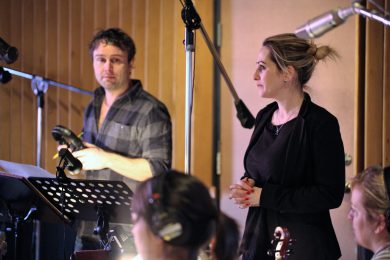From heartbroken rocker to film music producer and composer, this musician and businesswoman now feeds her passion for short-, medium- and feature-length films.
 “Be a good boy, my love” are the words spoken by Anik Jean’s character to Nathan, her six-and-a-half-year old son, as she’s leaving for the evening with her husband (played by Jean-Nicolas Verrault), and before the little monster gives his stupid babysitter the hardest time of her life. That’s the set-up for Sois sage, the 12-minute short film she recently directed and presented at the Fantasia Festival as part of the Fantastiques Week-ends du cinéma québécois. The film was produced by her production company, Nathan Films, which she co-manages with Milaine Gamache. She is also partnering with her husband Patrick Huard in Jesse Films, a company that creates feature films and TV productions.
“Be a good boy, my love” are the words spoken by Anik Jean’s character to Nathan, her six-and-a-half-year old son, as she’s leaving for the evening with her husband (played by Jean-Nicolas Verrault), and before the little monster gives his stupid babysitter the hardest time of her life. That’s the set-up for Sois sage, the 12-minute short film she recently directed and presented at the Fantasia Festival as part of the Fantastiques Week-ends du cinéma québécois. The film was produced by her production company, Nathan Films, which she co-manages with Milaine Gamache. She is also partnering with her husband Patrick Huard in Jesse Films, a company that creates feature films and TV productions.
“I’m producing for TV and film, I’m going through a creative boom,” says Jean. “It’s mind-blowing. I’m playing ping-pong with my projects. And I want to prove to the film people that I’m not an imposter.”
Anik Jean became known thanks to Bon Cop Bad Cop 2. “Patrick wanted me,” she says. “’Find yourself a Plan B,’ I told him, but in his pigheadedness, I was the one. With 72 cues for an 85-minute film, it’s a big load. For instance, I had to use the score to get cars that were too slow to sound like they were moving faster. I added lots of percussion instruments to bring out the high-speed effect. Sometimes you need 12 seconds of music, sometimes you need 47. It all depends on the scene. In Bon Cop 2, you know there’s music, but you don’t hear it.
“I love being in the studio, the process is a blast,” she continues. “I enjoy the group work, among others, with the producer and the editor. The communication is non-stop. But the hardest thing is to take the plunge. For a film like Bon Cop Bad Cop 2, I worked with digital sound effects software that reproduced the sounds of explosions or revving engines, but for Sois sage, it’s me at the piano and Catherine Ledoux on violin. There are creepy moments that only two instruments are capable of portraying. I was in my element, because I love the horror genre, but it’s important to calibrate the music properly, otherwise it’s going to ruin the film.”
Sois sage is the third film that Jean has scored. In February of 2019, as an opener for Les Rendez-Vous Québec Cinéma, she presented La Porte, a 15-minute short film in which Huard plays the part of an agoraphobic painter. In 2016, her 62-minute Lost Soul, a musical film without dialogue, launched her filmography. The artist is now busy writing two feature films, including one with the horror maestro Patrick Sénécal as a screenwriting advisor, as well as the music of a well-known TV series which she’s not yet allowed to identify by name.
“Martin Léon helped me with Bon Cop 2,” she says. “Whenever I was freaking out, I’d call him, because I needed someone to reassure me. I was receiving edited film scenes as an inspiration, and after viewing them, I would sing melodies over the phone to him, and he would transcribe them into music scores. He added eight violins, four brass instruments on some parts, and working with him is awesome. Same thing with guitarist Guillaume Doiron, a childhood friend who has a full arsenal of pedals that he uses knowledgeably.”
Is she not, however, neglecting the singer-songwriter career that she launched in 2005 with her Jean Leloup-produced first album Le Trashy Saloon (winner of the JUNO Award for Francophone Album of the Year)? A career that was boosted by her performance opening a January 2006 Rolling Stones concert? Isn’t she turning her back on her Keith Richards- and Ronnie Wood-autographed Gibson Firebird, and her Ron Wood Signature Telecaster (she owns 19 guitars)? And on her Discovery of the Year ADISQ Award?
“I was sick and tired of doing an album, then a tour, then an album, then a tour,” says Jean. “But now, I’ve just started writing my next record. And you know what? I attended the release of Jean Leloup’s latest album in April, and I feel like making another album. I have a concept in my head of blending a ‘Best Of’ and collaborating with the singer-songwriters that have inspired me to make music. I’ve called, and they’ve accepted the invitation to join in the adventure. So together, we’ll co-write some new songs.”